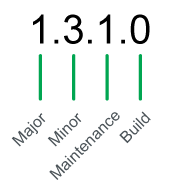
One tends to write a lot of Bash scripts when using Bazel. In order to make these scripts more robust, enable Bash’s unofficial strict mode by starting all scripts like this:
Read more...
One tends to write a lot of Bash scripts when using Bazel. In order to make these scripts more robust, enable Bash’s unofficial strict mode by starting all scripts like this:
Read more...
Bazel requires all files to end with LF (not CR-LF) in order to work correctly.
If you are performing cross-platform Bazel development with Windows users, you
can force this setting for all text files in your repo by creating a
.gitattributes file with the following content:

Quick Bazel tip for today: If you want to build everything except for a specific
subtree, you can prefix the subtree you want to exclude with a -.
For example, to build everything except for //client_access_library/...:
bazel build -- //... -//client_access_library/...

Bazel’s philosophy strongly encourages binding to exact, specific versions of all third-party dependencies to help ensure reproducible builds. As Bazel users, we must remember to extend this philosophy to Bazel itself.
When setting up a Bazel-based build system, you should choose a specific version of Bazel and require all developers and the build system to use it. This can be done in a few ways:
.bazelversion file (recommended)With the first approach, upgrades to Bazel can then be treated like any other
upgrade: submit a pull request to the repo which updates the value in the
.bazelversion file and runs the full continuous integration pipeline.

When writing custom Bazel rules, you spend a lot of time either
reading or writing Bazel File objects.
File objects have two properties for accessing the underlying
file path: File.path and File.short_path. When
writing custom rules, I often chose one of the two properties at
random, and switched to the other if it didn’t work right.
I wrote some simple custom rules to test the various combination
of rule types and file types to determine when I should use path
or short_path. The custom rules used bash script templates
that were populated with file paths, such as:

Bazel is a powerful yet complicated system, and it can be intimidating to newcomers.
While the Bazel user guide and user manual preach the benefits of giving Bazel full control over your build process by rewriting all build processes using Bazel-native rulesets (as Google reportedly does internally), this is an immense amount of work. Specifically, if you are integrating third-party software into your Bazel-based build process, reverse engineering and rewriting the third-party project’s build system into Bazel can easily take days – and then you need to maintain it.
Read more...
In 2020, I led the redesign and re-implementation of the object storage system behind RelativityOne.
As part of this project we reengineered the continuous delivery pipeline of the service to embrace the philosophy of a service-wide monorepo with a Bazel-based build system. We chose Bazel because we wanted a build system that could support many different languages (the service has code written in C, C#, Python, Go, Terraform, Packer, and other languages…) while remaining fast and correct.
Read more...